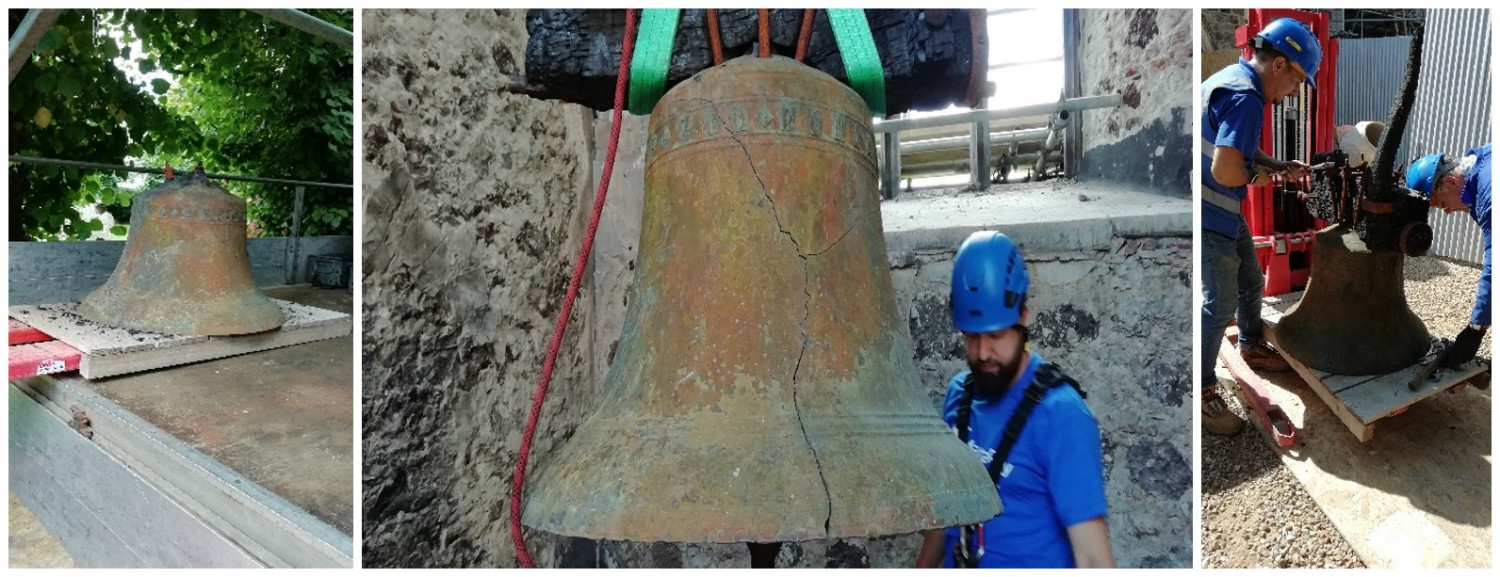The first bell being brought down!
Bell 1 is the oldest in the tower. It was cast in about 1350 by Thomas Derby and was in the tower until 6th August 2020 when it was removed for the first time. Until the fire, the bell was in reasonably good working order, with no cracks. Since the fire, a crack can be clearly seen, caused by the heating and then rapid cooling. The bell was loaded onto a lorry to initially go to the firm Soundweld, at Exning, before then going to White’s of Appleton Oxon Bellfounders.

Bell 2 was made around 1450 by Richard Brayser II, and was also badly cracked as a result of the heat from the fire and then rapid cooling afterwards.
 During the afternoon the third bell, made by Thomas Newman in 1726, was also lowered from the tower. It has been known that this bell has been cracked for many years.
During the afternoon the third bell, made by Thomas Newman in 1726, was also lowered from the tower. It has been known that this bell has been cracked for many years.
Where the bells now go
All three bells have now gone to Soundweld at Exning before being taken to White’s of Appleton Oxon. White’s of Appleton Oxon will decide what can be done after Soundweld have hopefully been able to weld the cracks.
The original schedule was to take three days to drop the bells from the tower. This included the lorry coming to and from Oxfordshire twice, and having a security guard on site for the night(s) that the bells were on the floor of the church. By completing the process in a day, the parish have made very significant savings.
DAC Meeting (Diocesan Architect’s Commission)
On Friday afternoon (August 7th) the team assembled in temperatures well over 30 degrees to climb the seven ladders that took them to the top of the tower for a DAC inspection.
Despite the heat, all seven of the team made it up to the top, a result in itself! The DAC are a distinguished group of experts in their own fields. Their advice, guidance and ruling on subjects ecclesiastical is the basis upon which all work of this nature is based. Parishes can appeal against a prescribed measure, but this process is seldom needed.
The following photos show how the situation looks now. Access had not been allowed during the bell lowering process for Health & Safety reasons.
 As well as being very charred, the Structural Engineer from Plandesil also found several places where both before and after the fire dry rot had taken its toll on the structure
As well as being very charred, the Structural Engineer from Plandesil also found several places where both before and after the fire dry rot had taken its toll on the structure
The DAC has advised that the frame is not of historic importance, heat and rot have done their worst, and so have advised that a full set of drawings be made for posterity. The cage can then be deconstructed and lowered for disposal. The same decision was made regarding the bell chamber floor that the cage sits upon, the floorboards and the beams, and the same for the floor below - where unused objects used to be stored over the years.
A view into the bell chamber from the scaffolding shows the bell cage and badly fired bell soundings. The frames and louvres of the bell soundings must all be removed and replaced. A temporary roof will be installed for protection and replaced by a permanent roof later in the process.
A view of the top of the south nave wall, (the wall is the light strip in the middle). The tops of the nave walls have now been weather protected by a bed of mortar. Inside the nave the walls have been lined with timbers and will now be clad in weatherproof plyboard to protect the walls over the winter.
A view of the village from the top of the tower.

In the coming weeks the entire inside of the tower will have been cleared of all charred timbers, floorboards and cross beams. One would, if permitted, be able to stand at the bottom of it and see nothing but sky through to the top.
It was suggested that when towers were built, in this case around 1440/60, the timbers needed to accommodate the floors and bell-chambers were built-in at the same time. Some of the beams used in the tower are about 8’’x 8’’. Oak timber of this dimension could only be felled from trees at least 300 years old at the time of felling. This dates the oak beams in the tower as at least, 900 years old!
We hope this is interesting to you and keeps you informed of the progress at St Mary’s, however slow things take to progress.
With thanks to Philip & Liz Wing, Churchwardens at St. Mary’s for providing the newsletter upon which this update entirely is based.
